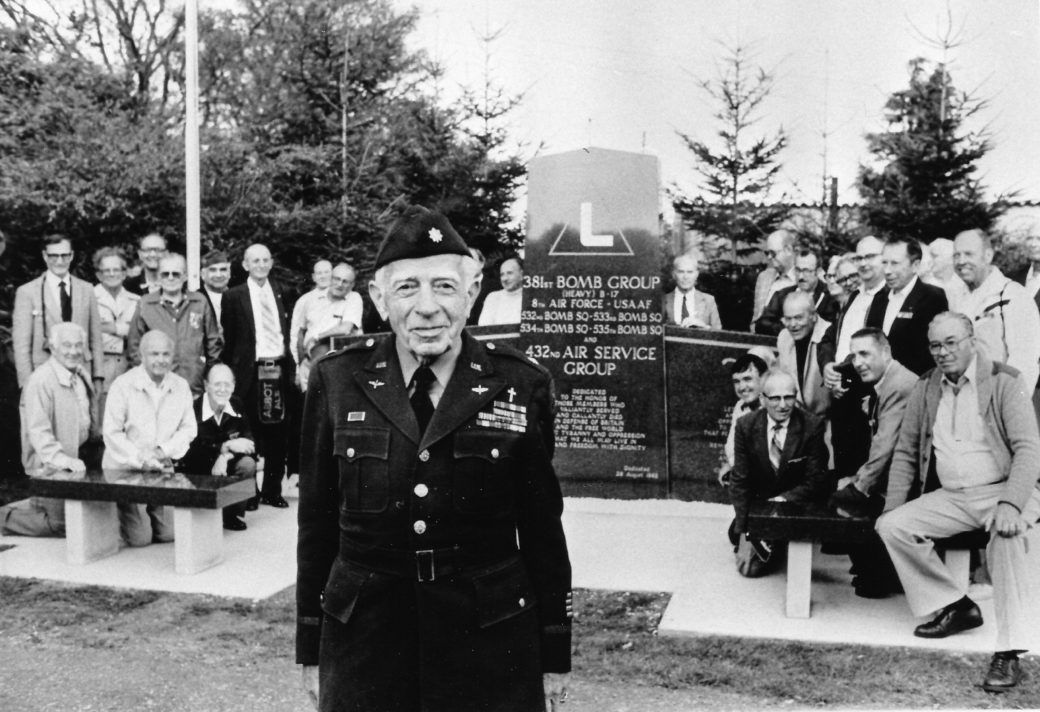Photo above: On August 28, 1982, scores of American veterans and their wives returned to Ridgewell to dedicate a memorial to the 381st Bomb Group. They were led by their former chaplain, James Good Brown, dressed in his ‘pinks and greens’. (Author’s collection)
When we think of World War II, iconic images of aircraft soaring through the skies and courageous pilots come to mind. One such group, the 381st Bomb Group of the Eighth Air Force, played a crucial role in the Allied air strikes against Hitler’s Germany. As we delve into the history of this remarkable unit, here are five facts you probably didn’t know about the 381st Bomb Group.
By the Casemate marketing team | 4 min read
Fact No. 1: Did you know that the 381st Bomb Group was a crucial part of the Eighth Air Force?

The Eighth Air Force grew at an astonishing rate following the arrival of a reconnaissance party in England in February 1942. To accommodate this expansion, nearly seventy airfields were hastily constructed across eastern England. At the heart of the Eighth Air Force were its bombardment groups, and the 381st Bomb Group was one such group. Equipped with Boeing B-17 Flying Fortresses and Consolidated B-24 Liberators, these heavily armed, four-engine bombers punched through the enemy’s defenses to strike vital targets.
Fact No. 2: Were you aware of the important role played by the 381st Bomb Group in Allied air strikes?
Throughout their time in Europe, the young American crews of the 381st Bomb Group played a vital role in the strategic bombing campaign of the Eighth Air Force. Over the course of their service, they flew an astonishing 297 bombing missions over Europe. These courageous men faced the dangers of enemy flak, fierce fighter opposition, and treacherous weather conditions as they carried out their missions. Their dedication and bravery made a significant impact on the outcome of the war.
Fact No. 3: Did you know that the 381st suffered two major non-combat tragedies?

During the course of its 297 combat missions, the 381st suffered the highest loss of any group on the first Schweinfurt raid on August 17, 1943. Eleven of its B-17s were shot down, taking 110 crew members with them. But two major tragedies also occurred outside of combat. On June 23, 1943, a day after the 381st’s first mission, one of its B-17s accidentally exploded on the ground at Ridgewell. Twenty-four men lost their lives, including a British civilian. It subsequently became the Eighth Air Force’s deadliest ground accident to occur in England. Two years later, a 381st B-17 carrying 31 men to Northern Ireland for rest and recuperation crashed into a hillside on the Isle of Man. All 31 were killed. To this day, it remains the Isle of Man’s worst air disaster.
Fact No. 4 : Did Chaplain James Good Brown Hold the Key to the 381st Bomb Group’s Courage?

Captain Brown had the challenging responsibility of tending to the spiritual needs of the young airmen striving to complete their 25-mission tour. However, the harsh reality was that during the 381st’s time in Essex, the statistical odds of reaching that milestone were grim. Despite the daunting circumstances, Brown endeavored to provide solace and support, grappling to comprehend the immense struggles faced by these brave men.
One of his heartbreaking duties included writing letters to grieving families, which became an almost daily occurrence. The summer and autumn of 1943 were particularly brutal, witnessing a severe decline in morale among the men, as the initial lofty optimism gave way to the harsh realities of war. Remarkably, James Good Brown lived a long and exceptional life, reaching the age of 107. He held the distinction of being the only chaplain to remain with the same bomb group throughout World War II, outliving all but one of his commanding officers.
Fact No. 5 : How High Were the Loss Rates of Crewmen in the Eighth Air Force Bomb Groups?
In early 1944, the Eighth Air Force conducted a comprehensive study on casualty figures and loss rates among crewmen in five bomb groups. The study examined a total of 2,085 crewmen over an 18-month period and revealed some startling statistics. It was found that 5.4 percent of the crewmen were lost in the first five missions of their 25-mission tours, with a significant number of losses occurring on the fifth mission specifically. Shockingly, the study concluded that only 25 percent of the crewmen managed to complete their full tour. These findings shed light on the immense risks and challenges faced by the brave airmen in the Eighth Air Force during World War II.
The story of the 381st Bomb Group is a testament to the bravery, skill, and sacrifice of the young American airmen who fought in the skies over Europe. Their role in the strategic bombing campaign, as chronicled in Bomb Group, is a vital chapter in the history of World War II. Through their remarkable journeys and heroic efforts, they helped turn the tide of the war, shaping the course of history.
WANT TO LEARN MORE?
Be sure to read Bomb Group: The Eighth Air Force’s 381st and the Allied Air Offensive over Europe.
”What this book on the 381st reminds us that the bomber war was fought by individuals and groups of young men. By homing in on one particular location and one bomb group, we are able to see the immense human drama of the bomber war through the experiences of these airmen.
The survivors are a generation slipping away all too fast, but as this book shows, their legacy remains.”
James Holland, Foreword


 Follow
Follow